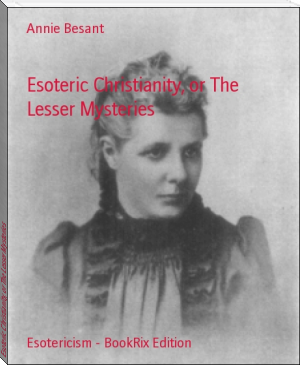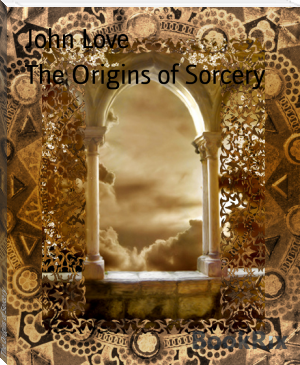Esoteric Christianity, or The Lesser Mysteries - Annie Besant (ebook reader that looks like a book .TXT) 📗

- Author: Annie Besant
Book online «Esoteric Christianity, or The Lesser Mysteries - Annie Besant (ebook reader that looks like a book .TXT) 📗». Author Annie Besant
The little band of chosen disciples whom He had selected as repositories of His teachings were thus deprived of their Master's physical presence ere they had assimilated His instructions, but they were souls of high and advanced type, ready to learn the Wisdom, and fit to hand it on to lesser men. Most receptive of all was that "disciple whom Jesus loved," young, eager, and fervid, profoundly devoted to his Master, and sharing His spirit of all-embracing love. He represented, through the century that followed the physical departure of the Christ, the spirit of mystic devotion that sought the exstasis, the vision of and the union with the Divine, while the later great Apostle, S. Paul, represented the wisdom side of the Mysteries.
The Master did not forget His promise to come to them after the world had lost sight of Him,[167] and for something over fifty years He visited them in His subtle spiritual body, continuing the teachings He had begun while with them, and training them in a knowledge of occult truths. They lived together, for the most part, in a retired spot on the outskirts of Judæa, attracting no attention among the many apparently similar communities of the time, studying the profound truths He taught them and acquiring "the gifts of the Spirit."
These inner instructions, commenced during His physical life among them and carried on after He had left the body, formed the basis of the "Mysteries of Jesus," which we have seen in early Church History, and gave the inner life which was the nucleus round which gathered the heterogeneous materials which formed ecclesiastical Christianity.
In the remarkable fragment called the _Pistis Sophia_, we have a document of the greatest interest bearing on the hidden teaching, written by the famous Valentinus. In this it is said that during the eleven years immediately after His death Jesus instructed His disciples so far as "the regions of the first statutes only, and up to the regions of the first mystery, the mystery within the veil."[168] They had not so far learned the distribution of the angelic orders, of part whereof Ignatius speaks.[169] Then Jesus, being "in the Mount" with His disciples, and having received His mystic Vesture, the knowledge of all the regions and the Words of Power which unlocked them, taught His disciples further, promising: "I will perfect you in every perfection, from the mysteries of the interior to the mysteries of the exterior: I will fill you with the Spirit, so that ye shall be called spiritual, perfect in all perfections."[170] And He taught them of Sophia, the Wisdom, and of her fall into matter in her attempt to rise unto the Highest, and of her cries to the Light in which she had trusted, and of the sending of Jesus to redeem her from chaos, and of her crowning with His light, and leading forth from bondage. And He told them further of the highest Mystery the ineffable, the simplest and clearest of all, though the highest, to be known by him alone who utterly renounced the world;[171] by that knowledge men became Christs for such "men are myself, and I am these men," for Christ is that highest Mystery.[172] Knowing that, men are "transformed into pure light and are brought into the light."[173] And He performed for them the great ceremony of Initiation, the baptism "which leadeth to the region of truth and into the region of light," and bade them celebrate it for others who were worthy: "But hide ye this mystery, give it not unto every man, but unto him [only] who shall do all things which I have said unto you in my commandments."[174]
Thereafter, being fully instructed, the apostles went forth to preach, ever aided by their Master.
Moreover these same disciples and their earliest colleagues wrote down from memory all the public sayings and parables of the Master that they had heard, and collected with great eagerness any reports they could find, writing down these also, and circulating them all among those who gradually attached themselves to their small community. Various collections were made, any member writing down what he himself remembered, and adding selections from the accounts of others. The inner teachings, given by the Christ to His chosen ones, were not written down, but were taught orally to those deemed worthy to receive them, to students who formed small communities for leading a retired life, and remained in touch with the central body.
The historical Christ, then, is a glorious Being belonging to the great spiritual hierarchy that guides the spiritual evolution of humanity, who used for some three years the human body of the disciple Jesus; who spent the last of these three years in public teaching throughout Judæa and Samaria; who was a healer of diseases and performed other remarkable occult works; who gathered round Him a small band of disciples whom He instructed in the deeper truths of the spiritual life; who drew men to Him by the singular love and tenderness and the rich wisdom that breathed from His Person; and who was finally put to death for blasphemy, for teaching the inherent Divinity of Himself and of all men. He came to give a new impulse of spiritual life to the world; to re-issue the inner teachings affecting spiritual life; to mark out again the narrow ancient way; to proclaim the existence of the "Kingdom of Heaven," of the Initiation which admits to that knowledge of God which is eternal life; and to admit a few to that Kingdom who should be able to teach others. Round this glorious Figure gathered the myths which united Him to the long array of His predecessors, the myths telling in allegory the story of all such lives, as they symbolise the work of the Logos in the Kosmos and the higher evolution of the individual human soul.
But it must not be supposed that the work of the Christ for His followers was over after He had established the Mysteries, or was confined to rare appearances therein. That Mighty One who had used the body of Jesus as His vehicle, and whose guardian care extends over the whole spiritual evolution of the fifth race of humanity, gave into the strong hands of the holy disciple who had surrendered to Him his body the care of the infant Church. Perfecting his human evolution, Jesus became one of the Masters of Wisdom, and took Christianity under His special charge, ever seeking to guide it to the right lines, to protect, to guard and nourish it. He was the Hierophant in the Christian Mysteries, the direct Teacher of the Initiates. His the inspiration that kept alight the Gnosis in the Church, until the superincumbent mass of ignorance became so great that even His breath could not fan the flame sufficiently to prevent its extinguishment. His the patient labour which strengthened soul after soul to endure through the darkness, and cherish within itself the spark of mystic longing, the thirst to find the Hidden God. His the steady inpouring of truth into every brain ready to receive it, so that hand stretched out to hand across the centuries and passed on the torch of knowledge, which thus was never extinguished. His the Form which stood beside the rack and in the flames of the burning pile, cheering His confessors and His martyrs, soothing the anguish of their pains, and filling their hearts with His peace. His the impulse which spoke in the thunder of Savonarola, which guided the calm wisdom of Erasmus, which inspired the deep ethics of the God-intoxicated Spinoza. His the energy which impelled Roger Bacon, Galileo, and Paracelsus in their searchings into nature. His the beauty that allured Fra Angelica and Raphael and Leonardo da Vinci, that inspired the genius of Michelangelo, that shone before the eyes of Murillo, and that gave the power that raised the marvels of the world, the Duomo of Milan, the San Marco of Venice, the Cathedral of Florence. His the melody that breathed in the masses of Mozart, the sonatas of Beethoven, the oratorios of Handel, the fugues of Bach, the austere splendour of Brahms. His the Presence that cheered the solitary mystics, the hunted occultists, the patient seekers after truth. By persuasion and by menace, by the eloquence of a S. Francis and by the gibes of a Voltaire, by the sweet submission of a Thomas à Kempis, and the rough virility of a Luther, He sought to instruct and awaken, to win into holiness or to scourge from evil. Through the long centuries He has striven and laboured, and, with all the mighty burden of the Churches to carry, He has never left uncared for or unsolaced one human heart that cried to Him for help. And now He is striving to turn to the benefit of Christendom part of the great flood of the Wisdom poured out for the refreshing of the world, and He is seeking through the Churches for some who have ears to hear the Wisdom, and who will answer to His appeal for messengers to carry it to His flock: "Here am I; send me."
CHAPTER V.
THE MYTHIC CHRIST.
We have already seen the use that is made of Comparative Mythology against Religion, and some of its most destructive attacks have been levelled against the Christ. His birth of a Virgin at "Christmas," the slaughter of the Innocents, His wonder-working and His teachings, His crucifixion, resurrection, and ascension--all these events in the story of His life are pointed to in the stories of other lives, and His historical existence is challenged on the strength of these identities. So far as the wonder-working and the teachings are concerned, we may briefly dismiss these first with the acknowledgment that most great Teachers have wrought works which, on the physical plane, appear as miracles in the sight of their contemporaries, but are known by occultists to be done by the exercise of powers possessed by all Initiates above a certain grade. The teachings He gave may also be acknowledged to be non-original; but where the student of Comparative Mythology thinks that he has proved that none is divinely inspired, when he shows that similar moral teachings fell from the lips of Manu, from the lips of the Buddha, from the lips of Jesus, the occultist says that certainly Jesus must have repeated the teachings of His predecessors, since He was a messenger from the same Lodge. The profound verities touching the divine and the human Spirit were as much truths twenty thousand years before Jesus was born in Palestine as after He was born; and to say that the world was left without such teaching, and that man was left in moral darkness from his beginnings to twenty centuries ago, is to say that there was a humanity without a Teacher, children without a Father, human souls crying for light into a darkness that gave them no answer--a conception as blasphemous of God as it is desperate for man, a conception contradicted by the appearance of every Sage, by the mighty literature, by the noble lives, in the thousands of ages ere the Christ came forth.
Recognising then





Comments (0)